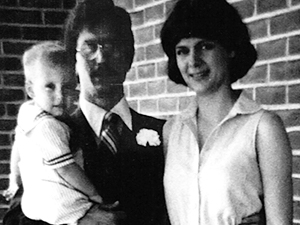
Author’s note: This post re-introduces our regular Photo Friday feature. Each week, we’ll feature a photograph — historic or contemporary — on the blog, and offer some context for it. For an example of Photo Friday posts, check out these archived posts.
In the months and years after September 1975, when the Vietnamese capital of Saigon fell to communist forces, U.S. news outlets began to air stories of refugees teeming out of southeast Asia. One Brethren in Christ pastor’s wife, Maralee Brubaker, became deeply moved as she saw the “pleading faces and malnourished bodies” depicted in these news stories. She and her husband Verle, then the pastoral couple at the now-closed Oak Park BIC Church (Des Moines, Iowa), knew they had to respond in some tangible way.
Although the Brubakers were young parents of an 18-month-old son, they decided to open the two unoccupied rooms in their parsonage to refugees. They met their foster children—Van and Vu, teenaged orphans who had escaped Vietnam—in November 1979. Less than a year later, they welcomed two other Vietnamese refugees, including Van and Vu’s brother Phat, into their home. The experience was not always easy, but in the process the Brubakers learned a valuable lesson in Christian discipleship. As Maralee wrote in 1981, “Expressing God’s love in this way renders us vulnerable—sometimes to be hurt. [But] it is only in so doing that we are able to receive love.”[1]
Expressing and receiving God’s love by caring for refugees occupied the time and energy of many U.S. Christians in the years after the Vietnam War, when millions of displaced people searched desperately for new homes and new lives. Within this broader current, several BIC congregations responded to pleas to aid war refugees in their resettlement.
For instance, in late 1975, members of Cross Roads BIC (Mt. Joy, Pa.) pooled their resources in order to help a seven-member Vietnamese family being relocated to the local community.[2] The Grantham (Pa) congregation made a similar decision that same year: church members worked together to secure housing and employment for a family that had escaped Vietnam on the same day that Saigon fell to communist forces; one couple from the congregation even taught the refugees English.[3] Similarly, in 1979, members of Palmyra (Pa.) BIC (now Encounter Church of Palmyra) sponsored the Vietnamese refugee Lu vin Ky, his brother Cuong, and four others members of Ky’s family as they started new lives in central Pennsyvania.[4] That same year, the Wainfleet (ON) congregation sponsored the Quach family as they resettled in Port Colborne, ON.[5] In time, some of these newly settled U.S. residents moved to different parts of the country; they built careers, purchased homes, and raised families. Meanwhile, some congregations continued to work with Vietnamese, Cambodian, and Laotian refugees well into the 1980s and beyond.[6]
Few BIC people in the 1970s and 1980s explicitly tied their work with refugees to the church’s historic peace position. And yet, as Maralee Brubaker’s comments point out, the same love for God and neighbor that fueled the church’s refusal to take up arms against enemy nations also fueled their compassionate response to displaced peoples. One member of Palmyra BIC invoked a biblical precedent for this generous, self-giving love in an article on how to sponsor refugee families. “Let us not be guilty of the sin of the priest and the Levite, who, seeing someone in great need, passed by” she wrote. “[Rather, let us be like] the Good Samaritan, [and] let us offer our help and our resources to these people who have suffered so much.”[7]
This post originally appeared in the Fall 2016 issue of Shalom!: A Journal for the Practice of Reconciliation. A shortened version of the post also appeared in the October 2016 issue of Connect, the newsletter of the Brethren in Christ Church in the U.S.
NOTES:
[1] The story of the Brubakers and their refugee foster children comes from Maralee A. Brubaker, “Stretching,” Evangelical Visitor, May 10, 1981, 5.
[2] J. Wilmer Heisey, The Cross Roads Story: A Brethren in Christ Community Living at the Threshold of Tomorrow (Grantham, Pa.: Brethren in Christ Historical Society, 2004), 181.
[3] E. Morris Sider, Celebration: A Centennial History of the Grantham Brethren in Christ (Grantham, Pa.: Brethren in Christ Historical Society), 256-258.
[4] Carolyn E. Pertusio, “Journey from Despair to Hope,” Evangelical Visitor, December 10, 1979, 9-10; Carolyn E. Pertusio, “Some Do’s and Don’ts Concerning Sponsorship,” Evangelical Visitor, January 10, 1980, 5.
[5] Lois Jean Peterman, “The Quachs Go to Sunday School,” Evangelical Visitor, July 10, 1980, 12.
[6] For instance, Grantham BIC went on to aid in the resettlement of several other Vietnamese families. See Sider, Celebration, 258-263.
[7] Pertusio, “Some Do’s and Don’ts,” 5.
